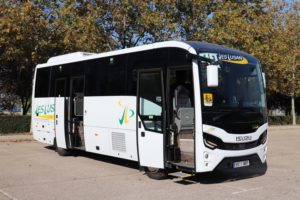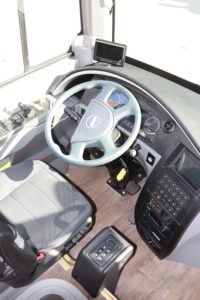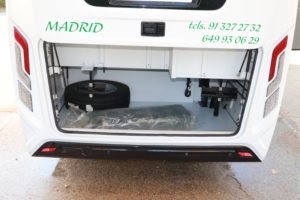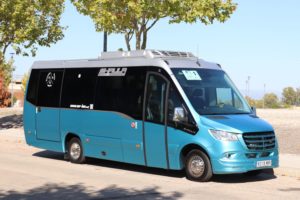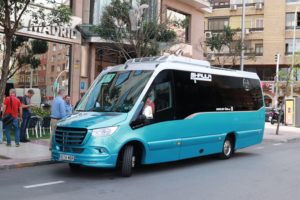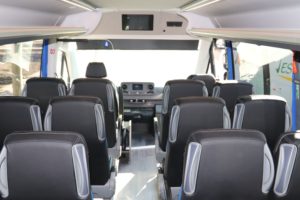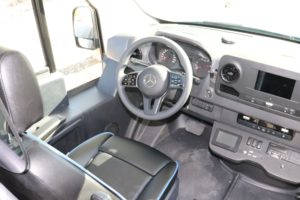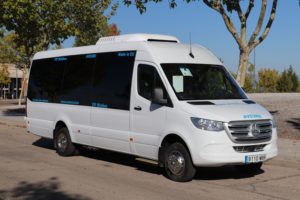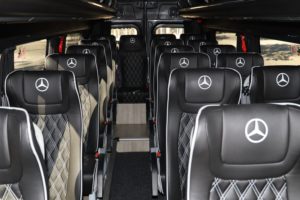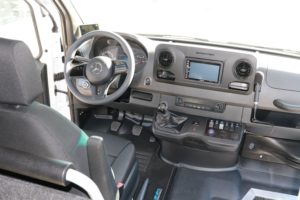Minibuses line up for Minibus Euro Test
Only one of the three finalist minibuses is available in the UK – the Anodolu Isuzu Grand Toro – but the others had plenty to suggest the direction of travel for minibus design, reports Stuart Jones, B&CB’s Founding Editor, from Madrid
Intended to be staged biennially in the build up to the FIAA bus and coach exhibition in Madrid, the Minibus Euro Test returned last week after last year’s planned event was a Covid casualty. Organised by the Spanish magazine autobuses & autocares, IFEMA Madrid and the FIAA on behalf of the International Bus & Coach of the Year Jury, it was held to identify the winner of the International Minibus of the Year 2023 award.
Open to standard versions of tourist or coach vehicles up to 9m long with any type of driveline, it saw leading specialist bus and coach journalists, representing countries across Europe assemble to test the three candidates entered, over a three day period prior to the opening of the show. The selection process involved walk round presentations, driving and travelling on each of them on public roads following an 8.3km route designed to show their strengths and weaknesses, and technical presentations from each manufacturer. The jury then discussed each vehicle at length before voting. The trophy was presented to the winner at an opening day ceremony.
This year’s very different candidates were: an 8.5m Anodolu Isuzu Grand Toro 35-seater ; a Mercedes-Benz Sprinter 517 with 19-seat extended conversion by Aveuro; and a coachbuilt 24-seat car-bus.net Shaula coach that employs Sprinter units but has a Muller 6.8 tonne rear axle and air suspension system. It had been hoped there would be more entries, among them Otokar, which launched the new 9.2m Navigo at the FIAA and, though it had hoped to, did not have examples of the 7.7m and 8.4m long variants available in time to participate as had originally been its intention. Instead it chose to become a sponsor of the event along with VDL Bus & Coach and the Spanish bus wash manufacturer, JMB, which has representation in the UK.
Anodolu Isuzu Grand Toro
Manufactured by Anodolu Isuzu at its large plant at Kocaeli Cayirova in Turkey which also produces trucks and pick-ups, the Grand Toro is part of a range of buses and coaches of between 7m and 18m produced. This includes the Turquoise, Novo, Visigo, Kendo and Grand Toro families of coaches. Of these, the Visigo and Grand Toro are available in right hand drive. Started in 1950, Anadolu Group has been working with Isuzu since 1983 and has a 16.99% share in the company, which is Turkey’s biggest exporter of buses, selling to over 40 countries. The greater part of sales (around 75%) now to European markets.
The largest of the three Minibus Euro Test entries at 8.516m, the Anodolu Isuzu Grand Toro was shown in a Class 3 35-seat school coach execution for a Spanish operator. Fitted with a 4.5-litre Cummins B4.5E6E210B engine developing 210hp driving through an Allison T3270R six speed automatic transmission with intarder, this was 2.35m wide with a 4.475m wheelbase. The gearbox is a push button unit with a display that shows the gear selected. Prepared for the subsequent installation of a Dhollandia lift accessed through the standard nearside rear emergency door, it had tracking fitted at the nearside rear and the necessary Q-Straint restraint systems already in place. With courier seat, the standard seating capacity is 35, reducing to 32 (including the wheelchair passenger) if a wheelchair is carried. Not specifying the courier seat gives another two seats taking the total to 37. If specified, the lift also greatly reduces the amount of luggage space in the boot from the standard 4.6cu.m. The rear luggage space is easily accessible with openings on three sides.
I had assumed that the name was a reference to Touring, but the Toro part actually references a bull, with the styling of the rear mouldings intended to suggest a bull’s head with its horns. It took me a while to spot that.
The Grand Toro will shortly be coming to the UK through EVM who have appointed Steve O’Neill to look after the brand. The specification has not been finalised yet but it will feature the Allison automatic transmission rather than the ZF manual box which is an option in some markets. Danny McGhee is putting a great deal of effort into ensuring that vehicles for the UK will be of a specification that properly matches UK requirements, though I am unsure whether it is this coach or a left hand drive demonstration coach that is scheduled to appear at the NEC.
On the road
The Grand Toro, which had only 1,118km on the clock at the start, failed to show off the full extent of its capabilities as a result of a couple of issues. Firstly, the Allison transmission has a mode switch with four different settings, each of which makes the vehicle behave quite differently. The four are: Economy, Economy Plus (only really needed on motorways), Power (for climbing mountains) and Comfort, the go-to option.
As a result drivers reported that the gears were holding far too long in the lower ratios and that it was difficult to apply power in a smooth or gentle manner. We subsequently learned that many purchasers block Power and Economy Plus off because Comfort will handle anything anyway. There wasn’t a motorway stretch on the route but a misreading of the route notes on the first run meant that we found ourselves on one and this showed up a discrepancy between the speed on the tachometer and the tachograph. Driver’s also noted vibration through the steering and that, while the throttle is floor mounted, the brake is hung from above.
The second problem was a fault on the rear air suspension which features a rigid beam axle with two air bags. This had a leak causing the bags to deflate and sit low. Resetting it only worked temporarily and it deflated again within a few minutes. The issue, which did not generate any indication on the dash, was not accurately diagnosed until testing was complete and unfortunately gave a harsh ride at the rear as well as increasing noise. The front axle is leaf sprung.
Despite these issues, there were positives about the vehicle’s performance. We did not measure it but the company claims that the Grand Toro typically returns around 16-17 litre per 100km (13.8 to 14.7mpg), a figure that journalists more familiar with the coach told me was a realistic claim. Although one colleague said that it ‘drove like a 12 tonne truck’ he nevertheless felt quite comfortable driving it. He liked that it felt planted on the road and didn’t throw you around.
For passengers, the previously mentioned issues compromised the ride quality but on the plus side the interior is bright and relatively spacious by virtue of the big windows, although it is only 2.35m wide. The centre door has a steep first step up from the ground, but the stairwell is roomy and the handrail provision is good. The front entrance has an extending first step which flexed a little when you stepped on it but again the handrails are relatively good, despite the presence of a courier seat to the left of the door aperture. When deployed, the near full width sunblind restricts the passenger view forward as well as stopping the driver seeing the external mirror over the screen which is intended to provide a clear view of the front. The driving mirrors are good on the passenger side but less so on the driver side.
Conclusion
I looked at a 37 seat demonstration coach (with no courier seat) to Class 2 specification on the stand at the subsequent FIAA and found its interior considerably more aesthetically attractive than the coach tested. It is probably fair to say that potential UK customers for the model shouldn’t be too put off by this relatively poor performance of one vehicle because the specification of a Spanish school coach and what EVM will bring to the market are very different, on top of which pre-delivery inspections and driver familiarisation would have eradicated the key negative issues. It is a flexible vehicle and at a price given as Euros130,000 represents quite a lot of capacity for the money.
Car-Bus Shaula
One of Spain’s indigenous producers, based at Manresa near Barcelona, Car-Bus.net offers an extensive range of small vehicles and has supplied the UK through EVM, producing the Grand Tourer GT model.
It is not doing so at the moment but is holding a number of potential orders and the intention is to start building again once there are sufficient to warrant the necessary investment costs. The business was launched in 1990 building products for Obradors (one of many former Spanish coachbuilders), subsequently building for Noge and opening a larger plant in 1999. The Alf Moseley dealership once looked at importing a Manresa built minicoach but I don’t think it was proceeded with. When Noge pulled out of the small coach market the business developed its own range and in 2007 became Car-Bus.net. It currently produces 17 units a month and offers a wide variety of products given Spanish names relating to the stars. It first offered a product called the Shaula in 2012 based on the tri-axle Mercedes-Benz Sprinter, selling six before the chassis was discontinued.
Since the demise of the Vario, Mercedes-Benz has not offered a product that filled its place, though coachbuilders and converters, as well as operators, have continued to seek one. There was the six tonne Sprinter for a while and there is the Sprinter 75, but the latter is not available as a chassis to converters who are becoming more inventive in seeking something that takes them beyond the Sprinter’s 5.5tonne GVW limit. Car-Bus.net began working with the German Muller company who developed an axle and air suspension system that enabled the Sprinter GVW to increase to 6.8 tonnes.
With this extra scope and the use of lightweight materials cladding a carbon steel frame, a 2.52m wide, 7.9m long coach was developed that could offer either 24 (four seat back row) or 25 seats (five seat back row) in a two plus two configuration together with a large boot and sidelockers. There are also versions that can give up to 27 seats and an accessible option that offers 13 seats, three wheelchair spaces and a side lift, utilising the standard rear nearside emergency door aperture, but with a reduced rear boot and no side lockers. The smaller boot results in the step up to the rear of the saloon floor being located nearer the rear.
The downside of changing the suspension is that it totally invalidates the Sprinter warranty forcing Car-Bus to completely certify the vehicle from scratch and provide its own warranty on it. This is two years on the driveline and five years on the body. It also means that the vehicle cannot carry the three pointed star badge, although Car-Bus is working hard to prove to Mercedes-Benz it can issue a letter of no objection over the matter, an endeavour that may or may not be successful. Mercedes-Benz’s objections only apply to products with the different suspension arrangement, not other products based on the standard Sprinter, including 19 seat versions of the Shaula.
Beautifully finished, inside and out and carrying a metallic blue colours scheme, the Shaula we tested was a 24 seater featuring wood effect floor, Sege recliners, though most other leading brands can also be offered. These were very comfortable units with plain black leather backs, and rouching, white piping, aisle armrests with carbon fibre effect finish, adjustable headrests with folding side panels and rear handholds. The recline mechanism is push button for the aisle seat, but the window seat recline is activated by pulling a loop which you can’t see if you have already sat down. Twin USB points are integrated in the body side, though they do require the aisle passenger to lean across the window passenger and trail leads across their lap too. There are substantial racks and a monitor is integrated within the front dome.
Single glazing was installed though double glazing can be specified. The large boot opens electrically but the controls for it are in the cab, which, though it closes automatically when driving, some felt was not ideal. One emergency roof hatch is installed above the rear axle.
On the road
Car-Bus had several goes at designing the frontal aspect of the coach before the final one was arrived at, with one of the hurdles they had to overcome being the thickness of the front pillars. Though the aesthetic outcome is excellent the view from behind the wheel still isn’t perfect to the left of the driver but the pillar is as thin as it can be made.
The original Sprinter mirrors are retained because it eases parts availability but some jurors would have preferred bigger ones mounted higher. There is a wooden box installed around the hand brake which protects it from the feet of boarding passengers, while the retarder fitted worked progressively.
There was universal praise for the nine speed automatic transmission and its matching to the two-litre four-cylinder bi-turbo engine. Likewise the rear axle which works well and keeps the coach stable. One juror commented, ‘It is the only one I could comfortably go a bit faster in.’
Taking the passenger perspective, I liked the Sege seats and also appreciating the styling and the ride quality, which was easily the smoothest. On top of this there was little or no vibration or extraneous noise from the body. An 18kW Webasto saloon air conditioning system was effective, the driver benefitting from the standard Mercedes-Benz cab system. Illuminated step edges were another nice touch.
Conclusion
We were told that the cost of a Shaula is between Euros125,000 and Euros155,000 (and it can be more) but that the coach we saw was around Euros130,000. This is quite a lot for a 24 seater but it is a very nice coach and one that provides an attractive passenger environment along with a good amount of luggage and excellent ride characteristics. I’m sure many would prefer to have the peace of mind of a warranty from Mercedes-Benz but that isn’t an option and it hasn’t stopped sales of the coach to date.
Aveuro Mercedes Benz Sprinter 517
I was not previously aware of the Romanian converter, Aveuro, which exports around 98% of its production, 80% of that to Israel, though it also has a strong and growing presence in France and Spain.
The company started in 2016 with a small factory and in 2020 moved into a new 8,500sqm plant which can produce two conversions a day, mostly on Sprinter but now also on Iveco Daily to cater for the 33 seat market. A recent development, shown at the FIAA show event is an electric city bus version of the Iveco Daily with the electrical equipment developed and built by the same Lithuanian manufacturer that produces the electrical systems for Sprinters supplied by Altas. The business is not currently represented in the UK, pre-Covid plans for a directly owned UK sales operation having been placed on hold as a result of the pandemic. The intention is that they be reactivated when market conditions are appropriate.
Aveuro MD, Vlad Papuc, told me that most of his customers were extremely cost conscious and did not want any extras that added to the cost of the vehicle, though the company could build on any version of the Sprinter. As the proprietors run their own 120 vehicle bus operation, they know about what customers want and apply it to their designs. The philosophy is to buy in parts made by specialists and assemble them rather than manufacturing items such as seats and racks in house, using their skilled labour force to carry out specialist jobs like the necessary metal work. Customers usually supply Aveuro with the base vehicle they want converting, though advice is given on what can and can’t be built on the different variants. All vehicles are built to Whole Vehicle Type Approval regulations certified in Belgium with over 100 different variants available.
Aveuro’s entry was based on the Mercedes-Benz Sprinter 517D panel van with two-litre, four-cylinder engine and six-speed manual transmission. This model has no air suspension and we were told that it couldn’t currently be fitted without invalidating the warranty although Mercedes-Benz will start offering it optionally from the latter part of next year. It did not have a retarder, something that Vlad reports is usual because costs a lot and delays delivery of the base vehicle. He reckons Aveuro have only ever built four Sprinters with retarders fitted.
Around half of Aveuro’s conversions have the body extended by 30 cm at the rear. This is a very professional extension which sees the spare wheel moved, on its original mountings, to just ahead of the rear wheel on the nearside. Stainless steel is used for all additional metal work beneath the vehicle.
With the standard double rear doors retained, there is good access through the 270 degree doors to the deep luggage boot which gives a capacity of ***cu.m. An idea picked up from an Israeli customer and since included within the Whole Vehicle Type Approval certification method is equipping the rear row of four seats to tip forward. This can enable more luggage space to be created if you have only 15 passengers, though I suggest there are negative safety implications in doing so. An alternative is to tow a trailer, Aveuro having tested their structure for a 750kg load. The standard front door is retained though a full electric glass plug door is an option for around €3,000.
On the road
Though it supplies higher specifications, most of Aveuro’s Sprinter conversions are for customers focused on price, hence the Sprinter 517 manual rather than the 519. Vlad explained that the inspiration for the vehicle was a Mercedes E-Class taxi.
Drivers told me that there was not much storage space for their personal effects in the cab area, though the useful pockets on each side of the front headlining were retained. The manual gearbox would make it less flexible to allocate in the UK. Drivers encountered a flat spot in the power between 15-20kph and the gap between second and third in the six-speed box could be tricky on steep hills.
For the passenger, the reconstituted leather seating, by the Turkish manufacturer GRL, looks excellent with its white piping, diamond stitching and prominent three-pointed star logos on every headrest. It feels comfortable too with the 2+1 layout and with 19 seats in the extended vehicle offers rather better legroom than on my flight to Madrid. It is legally possible to get 22 seats in the same extended minibus, a not infrequently specified option, but this would be quite tight. The seats to accomplish the change are supplied with each 19 seater. The same diamond/quilted steering pattern on the seats is carried over to the saloon sidecasings. Although the double glazed windows appear on the outside to be deep units, the window apertures are standard Sprinter on the inside. With the exception of the patterned illuminated ceiling which has mood lighting, nearly everything in the saloon is black, including the racks, which does make it slightly claustrophobic, but there are nice touches like the integrated USB points on the side walls and the illuminated ceiling panel. Originally a €1,200 option, the mood lighting ceiling was made standard earlier this year. Air conditioning is a roof mounted 16kW Autocool system. I thought it missed the air suspension as the ride at the rear, especially over speedbumps, could be harsh.
Conclusion
Though based on what UK operators would consider a very minimally specified Sprinter, on a 517 chassis with no power door, no retarder, no air suspension, double rear doors and no automatic transmission; nothing about Aveuro’s conversion was cheap in appearance and the finish quality was very high.
This is the more impressive as the coach was not one specially produced for the event, rather one already built and in Spain before entry to the competition was confirmed. The execution of the 35cm rear extension and the adding of the rear luggage compartment all looked professional and the initial impression given to passengers is an extremely positive one. We were quoted a price of Euros65,000 (not specifying the rear extension can reduce a 19-seater to Euros60,000) which is extremely competitive by European standards and gives an operator every chance to make a decent return, especially those using them on tendered contracts. Supplying the need is working for Aveuro, they are currently taking orders for June 2023.
Last word
After the votes were counted the Car-Bus Shaula emerged the winner. Not only was it the most comfortable to ride in and drive, it was also the most innovative of the entries, though the others also had strengths in terms of value for money and potential return on investment. The trophy was handed over to Jordi Monferrer Munoz, Car-Bus.net’s Commercial Director, during the FIAA event by International Bus & Coach of the Year Jury President, Tom Terjesen and representatives of the FIAA Show.
